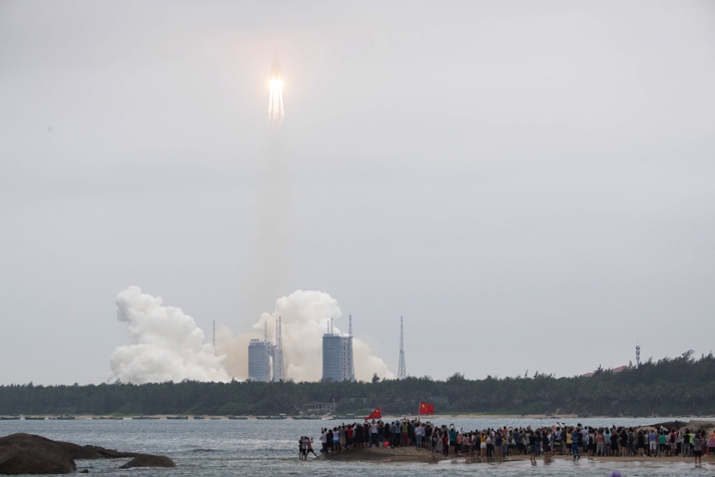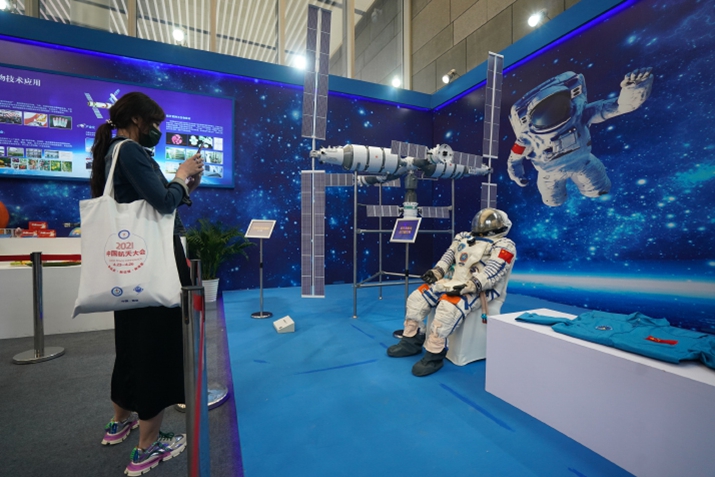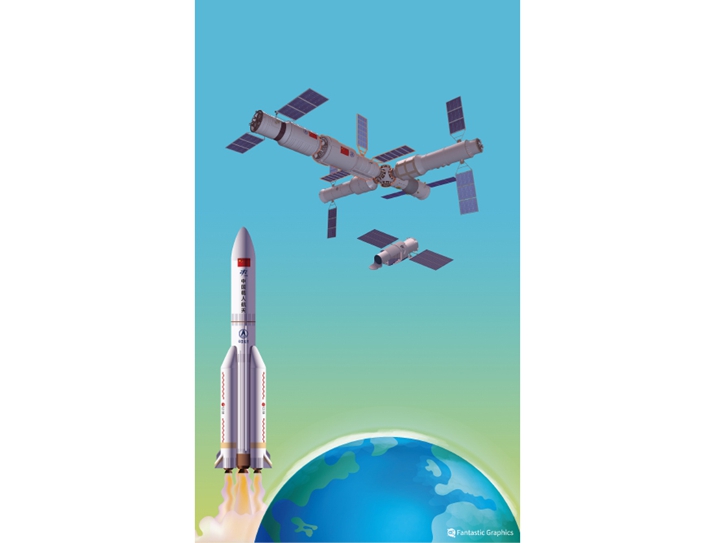| Top 10 Nation News Stories |
| Space Exploration | |
| A space infrastructure system for communication, navigation and remote sensing is also included in the plan to provide services to the world and make better contributions to humanity's use of space | |
|
|
 China launches the core module of its space station from the Wenchang Spacecraft Launch Site in Hainan Province on April 29 (XINHUA)
At 11:23 a.m. on April 29, a rocket blasted off from the Wenchang Spacecraft Launch Site in Hainan Province, carrying the core section of China's space station. After traveling a little over eight minutes on the domestically developed Long March-5B Y2 rocket, the module, named Tianhe, which means harmony of the heavens, separated from the rocket and entered into orbit. A key step in the construction of the space station that is expected to be completed next year, Tianhe will act as the management and control hub of the station as well as a node for docking with other spacecraft, up to three at a time, including both manned and cargo spacecraft. The successful launch marks China's space station construction entering the full implementation stage, laying a solid foundation for follow-up tasks, President Xi Jinping said in a congratulatory message. The space station, Tiangong or heavenly palace, will be a crewed space station independently built with homegrown technologies. Besides Tianhe, it will have two other sections, Wentian and Mengtian. Expected to be launched next year, these are the space laboratories for conducting experiments in a wide range of areas including space medicine, technology and life science. "Building a space station and national space laboratory is an important goal of the three-step strategy of China's manned space program, and an important leading project to boost the country's strength in science and technology, as well as in space," Xi said. 
A visitor at an exhibition featuring space science and achievements during the 2021 China Space Conference in Nanjing, Jiangsu Province, on April 24 (XINHUA)
Three-step plan When China's manned space program started in 1992, the first step was to send astronauts into space and have them return safely. Shenzhou-1, the country's first experimental manned spacecraft, was launched with no crew in 1999 and four years later, Shenzhou-5 successfully sent Yang Liwei, China's first astronaut into space. Yang, a military pilot, was 38 at that time. The milestone feat made China the third country to send astronauts into space. The second stage was to test key technologies needed for a permanent space station, including extra-vehicular activities and orbital docking. In 2008, fighter pilot Zhai Zhigang ventured out of the Earth-orbiting Shenzhou-7 spacecraft and walked in space, becoming China's first taikonaut to leave a "footprint in the universe." To amass more experience for developing a space station, an experimental space lab, Tiangong-1, was lifted up in 2011 to test the technologies for rendezvous and docking between spacecraft. A month later, Shenzhou-8 entered into orbit and accomplished the first automatic rendezvous and docking with Tiangong-1. In 2016, an improved version, Tiangong-2 was launched. It docked with Tianzhou-1, China's first cargo spacecraft, in April 2017, which also carried out the first in-orbit refueling. So far, China has launched 11 manned spacecraft, one cargo spacecraft, and Tiangong-1 and Tiangong-2 into space, as well as sent 11 astronauts, and completed the first two steps of its manned space program. "Progressing steadily with systematic and long-term planning—this is an example of how we do things," Zhou Jianping, chief designer of the Chinese manned space program, told Xinhua News Agency. The third step is to assemble and operate a permanently crewed space station. The successful flight of the new large carrier rocket Long March-5B in 2020 inaugurated the new stage in the manned space program. With work having started on assembling a space station that will be permanently crewed, four more missions have to be completed this year. The Tianzhou-2 cargo spacecraft and Shenzhou-12 manned craft will dock with Tianhe. The three astronauts aboard Shenzhou-12 will enter the module and stay in orbit for three months. Then, cargo spacecraft Tianzhou-3 and manned spaceship Shenzhou-13 will dock with Tianhe, and another three astronauts will begin their six-month stay in orbit. So far, the longest stay in space by Chinese astronauts has been 33 days. Tianhe will also be a platform for scientists to verify key technologies, such as flexible solar wings that are used to provide electricity for spacecraft. "It is bound to enrich our understanding of the universe and promote the development of science, technology and applications," Zhou said. "Every mission is a test for our organization, management, technology and support ability." 
Long March-5B Y2 rocket (VCG)
A home in space When completed, the space station will be T-shaped with Tianhe at the center and a lab capsule on each side. It is designed to serve 10 years in low-Earth orbit at an altitude of 340 km to 450 km. However, the lifespan can exceed 15 years with maintenance. "We will learn how to assemble, operate and maintain large spacecraft in orbit, and we aim to build Tiangong into a state-level space lab supporting the long stay of astronauts and large-scale scientific, technological and application experiments," Bai Linhou, deputy chief designer of the space station at the China Academy of Space Technology under the China Aerospace Science and Technology Corp. (CASC), told Xinhua. He said the station would be able to support maximum six astronauts together. If the Tiangong-1 and Tiangong-2 are like one-bedroom apartments, the space station can be regarded as a spacious apartment with three bedrooms, a living room, a dining room and a storage, more than six times the area of Tiangong-2. Crewed and cargo spaceships will be launched regularly for long-term manned presence to carry out in-orbit research and services. The station will provide the visitors with a comfortable environment, and zones for work, sleep, sanitation, dining, healthcare and exercise with convenient facilities and advanced technology. For instance, in Tianhe, the crew will be supported by a new system that recycles urine, exhaled breath condensate and carbon dioxide for different uses, such as flushing toilets or experiments. This will reduce the load of the spacecraft and cut operating costs. "We will develop the technology step by step, first recycling water and oxygen in Tiangong, and then planting vegetables and crops in space to gradually realize food self-sufficiency," Bai said. Global cooperation After 2024, the International Space Station (ISS), currently the only space station in orbit, built and operated by the space agencies of several countries, is due to retire. If that happens, then Tiangong, about a quarter of the size of the ISS, could be the only space station in Earth's orbit at that time. China is not a partner in the ISS consortium, nor has any Chinese astronaut visited the station. Initially excluded as the fledgling Chinese space agency was regarded as being too inexperienced to contribute to space programs, China has still not been included despite the rapid development of its domestic space endeavors. However, the Chinese Government has said that it would welcome international participation in Tiangong. "The station will contribute to the peaceful development and utilization of space resources through international cooperation," Bai said. A white paper published in 2017 clarifies China's position on space development, saying it is for peaceful purposes and opposed to militarization of space. China welcomes UN members to use the space station and has announced nine international projects with the UN Office for Outer Space Affairs (UNOOSA). China also looks forward to foreign astronauts' participation in the space station in the future because international cooperation will promote understanding between countries as well as lower costs. So far, 17 countries have confirmed their participation in the nine projects and in the future, China and UNOOSA will continue to explore more cooperation projects. From past to future China's progress in space technologies and activities prove that innovation with self-reliance is the foundation of a country's development of cutting-edge science, Wang Yajun, a CASC executive, said at a forum of China Space Conference on April 25. The conference was organized by the Chinese Society of Astronautics in Nanjing, Jiangsu Province. After the founding of the People's Republic of China in 1949, there were unremitting efforts to develop advanced technologies despite restricted financial, talent and technical resources. In 1970, China's first artificial Earth satellite Dongfanghong-1 was successfully launched, marking the beginning of the nation's extraterrestrial exploration. "That also helped strengthen China's national defense capability and promoted its scientific and technological development as well as economic growth," Wang said. After launching its first recoverable satellite in 1975, China for the first time launched three satellites on one rocket in 1981, another breakthrough in space technology. Four years later, it announced its decision to enter the international commercial launch market, making the first foray into the international space industry in 1987, providing launch services for European aerospace manufacturer Aerospatiale Matra. However, the path of self-reliance does not mean excluding international cooperation and exchange but introducing foreign technologies in a selective way to enhance research and development efficiency, Wang said, adding, "We should hold an inclusive attitude, and at the same time, adhere to Chinese characteristics." Last year, construction of the homegrown global navigation system BeiDou was completed. Started in the 1990s, it was constructed in three stages. Last year also saw the successful conclusion of China's three-step lunar exploration program of orbiting, landing, and bringing back samples. It had started in 2004 and last December, the return capsule of the Chang'e-5 lunar probe touched down in Inner Mongolia Autonomous Region, bringing back samples from Moon. In 2016, the number of space launches reached 22 in China, then to 39 in 2020. In 2021, the CASC alone has over 40 space launches planned, and the total number is likely to be higher with other companies, especially commercial space companies, also planning similar ventures. In the 14th Five-Year Plan (2021-25) period, priority science and technology projects in aerospace will be promoted and aerospace will be boosted as a strategic emerging industry, Zhang Kejian, head of the China National Space Administration, said. These will include the lunar exploration program's fourth phase, in which China plans to build an international lunar research station on Moon, interplanetary exploration such as asteroid reconnaissance, heavy-lift carrier rockets, and reusable space transportation systems. For instance, China's first independent interplanetary mission, Tianwen-1, is scheduled to land a rover on Mars soon for scientific tests. It entered the Mars orbit on February 10, following a nearly seven-month voyage from Earth, and sent back images of the red planet in March. A space infrastructure system for communication, navigation and remote sensing is also included in the plan to provide services to the world and make better contributions to humanity's use of space, Zhang said.
(Print Edition Title: Another Giant Leap) Copyedited by Sudeshna Sarkar Comments to liqing@bjreview.com |
|
||||||||||||||||||||||||||||
|